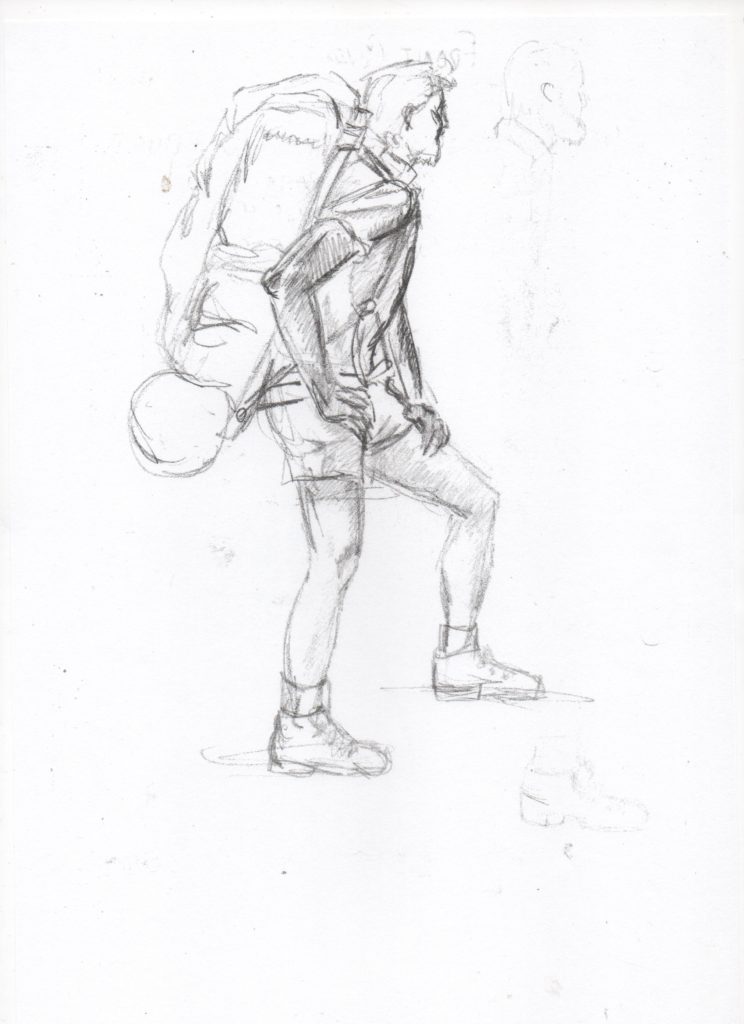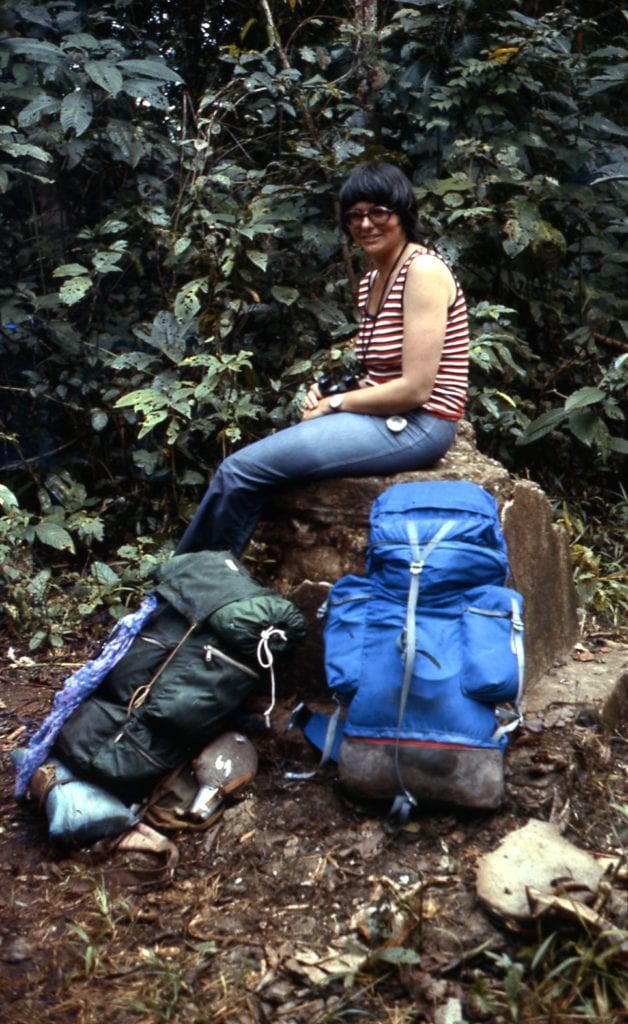In the second instalment in this series, Hilary Bradt reminisces on the early days of Bradt Enterprises, when books cost only £1.50 and could be sold from a Greyhound bus.
We didn’t mean to be called Bradt Enterprises. Our choice was Esperanza Books. Esperanza is both the local name for a very beautiful South American butterfly (we had planned a logo) and the Spanish for ‘wait’, ‘expect’ and ‘hope’. All relevant. But Sally, George’s mother, made her own choice since the book was going to be a one-off, and she had some enterprising business plans in mind.
Becoming ‘Real Publishers’
We learned that there were two things Real Publishers needed: a logo, which would identify their brand; and an ISBN – that code on the back of all books that gives it a unique identity. The logo was the easiest part. We knew what our speciality would be – backpacking guides (in the American sense of hiking long-distance trails). We wanted to cover the rest of Latin America and thought we might as well add North America while we were at it.
So our logo would be a backpacker. I still have the original drawing – and I remember my mother’s reaction when she came into the kitchen at midnight to turn off the lights and found George standing in full hiking gear with one foot on an upturned waste-paper basket and me sketching him. ‘Oh God!’ she said, and left the room. That logo defined the company for several years.

An ISBN was more problematic. We just couldn’t get to grips with it, and in the days of communicating only by mail, we had a protracted correspondence with a Miss Budworth at Whitakers. She was very patient. When the two books were published, Miss Budworth received a single rosebud by Interflora.
I was working as an occupational therapist while George was haphazardly printing the books – one of us needed to earn some money – so he had the job of selling them. He went to Stanfords, then and now the biggest and best travel bookshop in Britain. Yes, they could definitely sell those unusual books. We’d decided on the price: £1.50 for Backpacking in Peru and Bolivia and £2.00 for Backpacker’s Africa. ‘What discount do you give?’ asked the buyer. Discount? We’re supposed to give a discount?
‘Um, the usual.’
’35 per cent?’
‘Yes, that’s right’. Phew! All sorted.
Every October there is a huge book fair in Frankfurt. George hitchhiked there in 1977 with our two books, and returned starry eyed. ‘I met this German guy, Martin Velbinger. He publishes guides to Greece and sells thousands of copies! He bought a good car and drives around the country visiting bookshops. He says you can make good money as a publisher. And he wants to translate our books into German!’
It had never occurred to us that we could actually make a living at publishing. Martin came to visit us in England (still at my parent’s house. Poor parents!). He talked non stop for 24 hours (none of us went to bed) then returned to Germany. We hadn’t been able to agree terms for the translation but we had a different future mapped out. I would give up my job and we would research our next guidebook while accomplishing a hike we’d had in mind for some time: a crossing of the Darien Gap. Perhaps we really could make a living out of travel.
1978
Most of 1978 was spent in the US, staying with long-suffering friends in Boston and travelling to Latin America to research Backpacking in Mexico & Central America and then Backpacking in Venezuela, Colombia & Ecuador. My father filled the orders that arrived in Britain, and kept meticulous accounts, observed by our African grey parrot, Captain Flint, who perched on the typewriter, falling off every time my father did a carriage return. We also produced our first ‘catalogue’ – a single A4 sheet.



We used the brilliant system of drive-away cars to get around America, and from Boston to Miami and thence to South America. Car-owners wanting their automobile taken to their summer home would risk having people like us drive it for them. They paid an agency to check us out (we briefed the friends who’d been coerced into being referees), we paid nothing apart from petrol, and we saw a bit of America. We’d put the car through a car wash near the destination and put on our best clothes and nicest smiles. Sometimes we got a tip and a couple of times the car was a Cadillac. It was fun putting the make of car on the form when we pitched up at an ultra seedy motel for the night.
By the end of the year we had researched, written, and illustrated two books. These even had a spine so that bookshops could sell them more easily. And maps. Both were typewritten, but we did nice chapter headings with letraset (stick-on letters) and had Mexico & Central America printed at a school for the handicapped in Boston. The kids did a super job and the teacher was thrilled to have a proper commercial project.
Selling books
Normal publishers use a distributor to sell their books. We used Greyhound buses and a Eurail pass.
In 1979 the Greyhound bus company sold coast-to-coast travel passes for US$99 as a ‘Thank you Canada’ gesture. Canada, or rather the Canadian Embassy, had helped six American diplomats escape when the US Embassy in Tehran was seized in 1979. We weren’t Canadians so I’m not sure how this worked, but it meant that we could travel throughout the US for an unlimited amount of time, stopping in all the major cities to sell books.

I can’t pretend I enjoyed it. Most nights we slept on the bus or sometimes pitched our tent in city parks. Occasionally we’d stay at a YMCA to get cleaned up. But we sold lots of books and made lasting friends with bookshop owners. We had a unique product at a time when Americans had embraced walking and travel with equal enthusiasm.
I bought a Eurail Pass in the US and did the same thing in Europe – travelling by train throughout the continent, staying with friends or sleeping on the train – and selling lots of books. I didn’t enjoy this either. It was a bit hit and miss, getting out in a new town or city, going to a telephone box and guessing what the word was for bookshop. ‘Do you speak English?’ Then I’d launch into who I was and what I had to sell, and most would agree to see me and most bought books. And now I had the contacts for reorders. And new friends who I visited annually for many years.
It was unorthodox, but it worked. What also worked was driving around Britain with books in the car boot, visiting bookshops and being paid there and then from the till. You can’t do that these days. Nor could you attend Frankfurt Book Fair with a backpack frame converted to a book display and walk up and down the travel hall. That worked too. The marriage ended in 1980 and after a tough few years the company became almost normal. But those early years had laid the groundwork.
Read Part Three here.